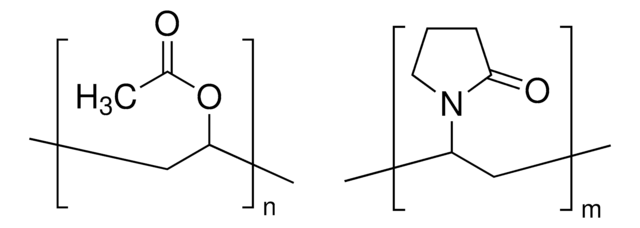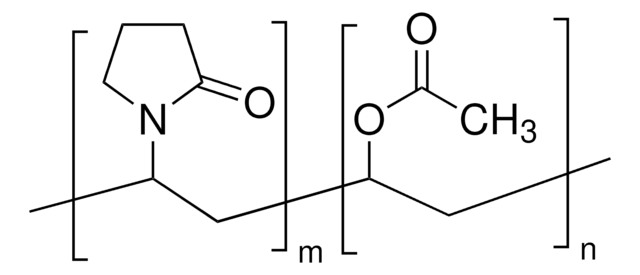02286
Kollidon® 25
Sinónimos:
Polyvinylpyrrolidone, PVP, Polyvidone, Povidone
About This Item
Productos recomendados
Nivel de calidad
impurezas
≤1 ppm hydrazine
≤10 ppm heavy metals (verified on random samples only)
≤10 ppm lead (verified on random samples only)
≤10 ppm vinylpyrrolidinone
≤3.0% 2-pyrrolidone
≤400 ppm peroxides (as H2O2)
≤5.0% water
≤500 ppm aldehydes (as acetaldehyde)
≤5000 ppm formic acid
12.0-12.8% nitrogen (anhydrous basis)
residuo de ign.
≤0.1% (verified on random samples only)
pH
3.0-5.0
idoneidad
complies for Infrared spectrum
aplicaciones
sample preservation
cadena SMILES
C=CN1CCCC1=O
InChI
1S/C6H9NO/c1-2-7-5-3-4-6(7)8/h2H,1,3-5H2
Clave InChI
WHNWPMSKXPGLAX-UHFFFAOYSA-N
¿Está buscando productos similares? Visita Guía de comparación de productos
Aplicación
Kollidon SR is a blend of polyvinyl acetate and povidone (K 30) in the ratio 8:2 for use as matrix-forming agent. This research grade product is intended for use in R&D and development only.
Otras notas
Información legal
Código de clase de almacenamiento
11 - Combustible Solids
Clase de riesgo para el agua (WGK)
WGK 1
Punto de inflamabilidad (°F)
Not applicable
Punto de inflamabilidad (°C)
Not applicable
Certificados de análisis (COA)
Busque Certificados de análisis (COA) introduciendo el número de lote del producto. Los números de lote se encuentran en la etiqueta del producto después de las palabras «Lot» o «Batch»
¿Ya tiene este producto?
Encuentre la documentación para los productos que ha comprado recientemente en la Biblioteca de documentos.
Los clientes también vieron
Nuestro equipo de científicos tiene experiencia en todas las áreas de investigación: Ciencias de la vida, Ciencia de los materiales, Síntesis química, Cromatografía, Analítica y muchas otras.
Póngase en contacto con el Servicio técnico


